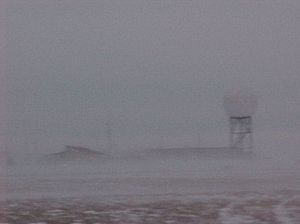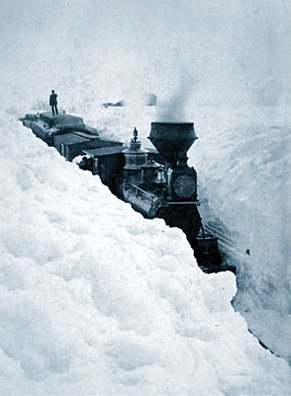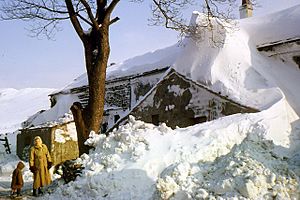Blizzard facts for kids
Quick facts for kids Blizzard |
|
|---|---|

A blizzard in Goodland, Kansas.
|
|
| Area of occurrence | Temperate and polar regions, high mountains. |
| Season | Usually winter. |
| Effect | Power outages, dangerous travel conditions. |

A blizzard is a very serious snowstorm. It brings super cold temperatures, very strong winds, and tons of blowing snow. Blizzards happen when a high pressure system (which means clear, calm weather) meets a low pressure system (which often brings stormy weather).
Sometimes, people use the word blizzard for any big winter storm. But a real blizzard is special! The main difference between a blizzard and a regular snowstorm is how strong the wind is, not just how much snow falls.
To be called a blizzard, a snowstorm must have steady winds or strong gusts that are at least 56 km/h (35 mph) (about 35 miles per hour). These winds must blow so much snow around that you can barely see. Your visibility (how far you can see) must be 400 m or 0.25 mi (about a quarter of a mile) or less. Plus, these conditions must last for a long time, usually three hours or more.
Contents
Where Do Blizzards Happen?
Some places get blizzards more often than others. But a blizzard can happen anywhere that gets snow.
Blizzards in North America
In North America, blizzards are common in the northeastern United States and in parts of Canada. In these areas, blizzards can happen more than twice every winter.
They also happen often in the mountain ranges of western North America. Because fewer people live in these mountain areas, blizzards there are sometimes not reported as much.
What is a Whiteout Blizzard?
A very dangerous type of blizzard is called a whiteout. In a whiteout, the falling snow and strong winds are so thick that you can't tell the ground from the sky. Everything looks white!
People caught in a whiteout can quickly lose their sense of direction. This is very risky for pilots flying airplanes. They can't see how close they are to the ground, which can lead to crashes.
How Do Blizzards Form?
For a blizzard to form, you need a few things:
- Cold Air: The air must be cold enough for snow to form in the clouds and fall to the ground.
- Moisture: You need water vapor (moisture) in the air to create clouds and snow. Cold air blowing over large lakes or the sea can pick up this moisture.
- Warm and Cold Air Meeting: While cold air is important, a lot of snow usually forms when cold air mixes with warm air. When warm air meets cold air, they create a "front." This front helps the warm, moist air rise into the clouds, where it turns into snow. This is how a blizzard really gets going!
How Strong Are Blizzard Winds?
Blizzards have very strong winds. The winds are steady or have frequent gusts of 35 miles per hour (about 56 km/h) or even stronger. These powerful winds are what make blizzards so dangerous, as they blow snow everywhere and reduce visibility.
How Cold Can Blizzards Get?
Blizzards can bring extremely cold temperatures, often dropping to -12 degrees Celsius (10 degrees Fahrenheit) or even lower. This makes it very easy to get hypothermia (when your body loses heat too fast) if you are outside. The freezing temperatures can also make electronics and machines stop working, which makes life very difficult during a blizzard.
What Are the Effects of a Blizzard?
Blizzards can cause many problems:
- Power Outages and Damage: Strong winds can knock out power, damage buildings, and make it hard for emergency services to communicate. People might be left without electricity, heat, food, or water.
- Travel Dangers: Blizzards are very dangerous for driving. Low visibility and icy roads can lead to many accidents, causing injuries or even deaths.
- Health Risks: If you are caught outside in a blizzard, your skin can lose feeling in just a few minutes. You could suffer from hypothermia or frostbite (when body tissue freezes). In very bad cases, this can even lead to death.
- Environmental Impact: Blizzards can harm the environment by killing plants and animals. This can affect the food chain, forcing some animals to find new food sources or risk starving.
- More Precipitation: Blizzards can change how much water vapor is in the atmosphere. This can lead to more rain or snow later in the year.
Famous U.S. Blizzards

The Great Blizzard of 1888 was a huge storm that hit the northeastern United States. About 400 people died, 200 ships sank, and snowdrifts piled up 10 to 15 feet high!
In the Great Plains, the Schoolhouse Blizzard trapped many children in their schools and killed 235 people.
The "Hard Winter" of 1880-1881
The winter of 1880–1881 was so bad that people in The Dakotas called it the "Hard Winter." The author Laura Ingalls Wilder wrote her book The Long Winter about this time. Her book tells the story of one blizzard after another and how it affected her family and everyone around them.
Much of her story is true. For example, two men from the town of DeSmet, South Dakota, really did go looking for wheat stored miles away in February 1881. If they hadn't found and brought back the wheat, the townspeople might have starved. Laura Ingalls later married one of these brave men, Almanzo Wilder. The snow and ice finally melted in April, and the railroads could start running again. The train picture you see here was taken on March 29, 1881, near DeSmet.
Other Notable Blizzards
In March 1920, a 3-day spring blizzard in North Dakota killed 34 people. One of them was Hazel Miner, a teenage girl who froze to death. She got lost on her way home from her one-room-school.
The Armistice Day Blizzard in 1940 surprised many people. The temperature was 60 °F (15.6 °C) in the morning, but by noon, it was snowing heavily. Some people froze to death in the snow. A total of 154 people died in this blizzard.
105 years after the Great Blizzard of 1888, a massive storm called the Storm of the Century hit the U.S. in 1993. It dropped snow on 26 states, reaching from Canada in the north all the way to Mexico in the south. In many southern U.S. areas, like parts of Alabama, more snow fell in this one storm than in an entire winter! Highways and airports across the U.S. had to close. This blizzard also caused 15 tornadoes in Florida. When the storm was over, 270 people had died, and 48 were missing.

Other famous blizzards include:
- The Blizzard of 1977
- The Great Blizzard of 1978, which had the lowest non-tropical atmospheric pressure ever recorded in U.S. history in Cleveland, Ohio.
- The Northeastern United States Blizzard of 1978
- The Halloween Blizzard of 1991, which dropped over 28 inches (72 cm) of snow on Minneapolis, Minnesota and caused $100 million in damage.
- The North American blizzard of 1996
- The Blizzard of 1999
- The North American blizzard of 2003
- White Juan (2004)
- The North American blizzard of 2005
See also
Images for kids
-
Blizzard at Tochal Skiing resort in Tehran, affecting skiers.
-
Near-whiteout conditions dim the far end of Times Square in New York City, 2015.
-
The Brooklyn Bridge during the Great Blizzard of 1888.
-
Conditions approaching a blizzard whiteout in Minnesota, on March 1, 2007. Notice how the horizon is unclear.
-
Stereoscopic view card showing "Blasting ice with dynamite from in front of steamer on the ways, by Stanley J. Morrow" ~ A view of Yankton's riverfront after the flood of March 1881.
See also
 In Spanish: Ventisca para niños
In Spanish: Ventisca para niños










